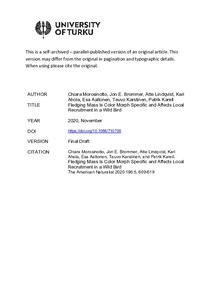Fledging Mass Is Color Morph Specific and Affects Local Recruitment in a Wild Bird
Morosinotto Chiara; Brommer Jon E.; Lindqvist Atte; Ahola Kari; Aaltonen Esa; Karstinen Teuvo; Karell Patrik
Fledging Mass Is Color Morph Specific and Affects Local Recruitment in a Wild Bird
Morosinotto Chiara
Brommer Jon E.
Lindqvist Atte
Ahola Kari
Aaltonen Esa
Karstinen Teuvo
Karell Patrik
UNIV CHICAGO PRESS
Julkaisun pysyvä osoite on:
https://urn.fi/URN:NBN:fi-fe2021042824770
https://urn.fi/URN:NBN:fi-fe2021042824770
Tiivistelmä
Early-life conditions may have long-lasting effects on life history. In color polymorphic species, morph-specific sensitivity to environmental conditions may lead to differential fitness. In tawny owls (Strix aluco), pheomelanin-based color polymorphism is expected to be maintained because the brown morph has higher adult fitness in warmer environments, while selection favors the gray morph under colder conditions. Here we investigate body mass at fledging and its consequences until adulthood in a population at the species' cold range margin. Using 40 years of data (1979-2017), we show that brown pairs, which mainly produce brown offspring consistent with a one-locus-two-alleles inheritance model, consistently raised heavier offspring than mixed (gray-brown) pairs and gray pairs. Offspring mass declined seasonally, except among offspring raised by brown pairs. Brown offspring could be heavier because of morph-specific parental care and/or offspring growth. Furthermore, mass at fledging is associated with fitness: the probability of local recruitment into the breeding population increased with higher mass at fledging, especially in mild winters and with favorable food conditions, although recruitment is not morph specific. Fledgling mass thus provides a fitness benefit in terms of recruitment probability that is modulated by environmental factors, which appear to level off any direct morph-specific recruitment benefits.
Kokoelmat
- Rinnakkaistallenteet [27094]
